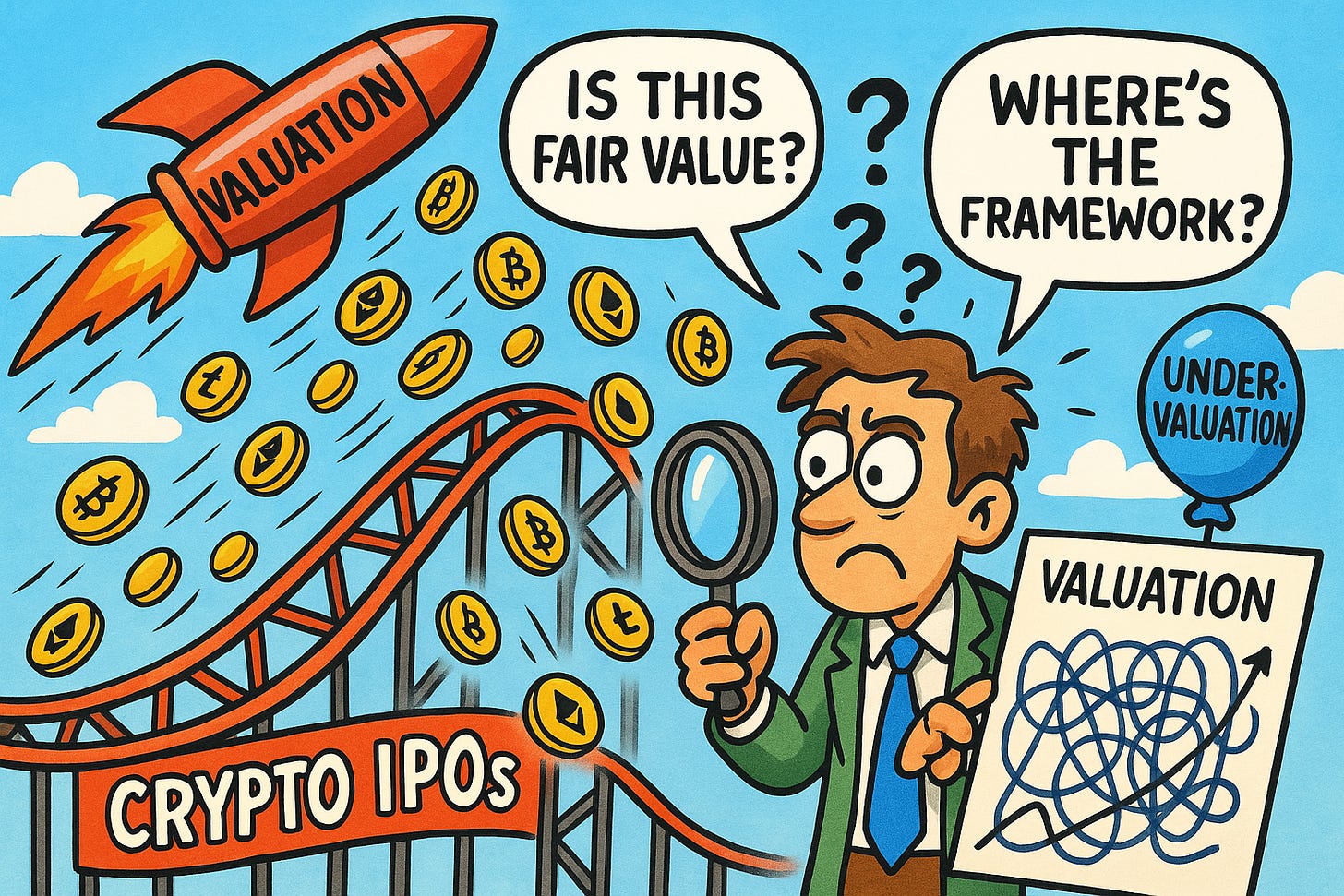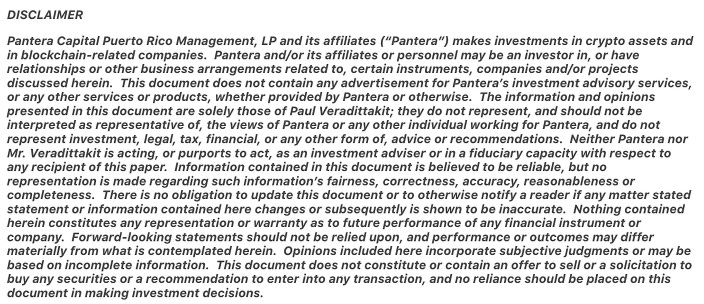Blockchain Going Public: the Convergence of Public Markets and Digital Assets
VeradiVerdict - Issue #334
Summary
Crypto IPOs are unlocking significant value, despite initial pricing challenges.
The token transparency framework aims to bring clarity and attract more institutional investment into the token market.
Tokenized stocks are revolutionizing financial markets, driving efficiency and expanding access to global capital.
Mispriced Crypto IPOs
The story of Coinbase since its IPO is a case study in how public markets struggle to price innovation at the edge of financial infrastructure. We’ve watched COIN swing from euphoric highs, opening 52% above its reference price and briefly touching a $100B valuation, to deep drawdowns, as sentiment and crypto cycles whipsaw the narrative. Each turn of the market seems to reprice Coinbase under a new valuation framework, leaving long-term value investors and builders alike scratching their heads. The Circle IPO is another recent example: despite massive demand for stablecoin exposure, Circle left $1.7 billion on the table in its debut, ranking among the most underpriced offerings of the last few decades. This isn’t just a quirk of crypto, it's a structural problem in how we bring next-generation financial companies to public markets.
Crypto needs a smarter, more adaptive approach to price discovery - one that can bridge the gap between institutional demand and the true value of these platforms as cycles shift.
Call for New Valuation Framework
Tokens still lack their S-1. Mispriced crypto IPOs have proven that when underwriters can’t map token economics to a GAAP-style checklist, meaning they either overpay on hype or underprice on fear. To close that gap, Pantera's Cosmo Jiang teamed up with Blockworks to launch the Token Transparency Report - 40 points that turn protocol opacity into IPO-grade clarity. The framework asks founders to break out revenue by entity, publish vesting curves with labeled insider wallets, and file quarterly token-holder statements on treasury, cash flow, and KPIs. It even pulls back the curtain on market-maker or CEX deals so investors can size liquidity risk before day one. Package those answers, and a startup hands Wall Street everything it needs to price itself for an IPO with confidence.
Why does this matter for valuation?
Lower discount rates: clear float and dilution data lets banks price closer to intrinsic value.
Larger buyer base: institutions previously barred from “black-box” protocols can participate after the framework certifies the protocol.
Regulatory fast-track: the SEC’s April 2025 crypto-offering guidance aligns with the framework’s pillars, so projects walk into the filing window with most of the paperwork already done - speeding approvals and tightening the spread between private and public valuations.
It is hard to view blockchains under the lens of traditional businesses. Ethereum’s latest upgrade makes the point crystal clear i.e. every new block destroys a slice of ETH (think auto share-buyback) while handing stakers a 3–5 % yield (think steady dividend). The right move is to treat issuance minus burn like free cash flow - discount it forward and you’ve got a valuation that fits the chain, not just the balance sheet. But scarcity is only chapter one, speed is the full story. A chain can cap supply all it wants, but real value shows up in the traffic - stablecoins moving across wallets, bridges' activity, DeFi collateral flow. Those live stats are the pulse that fundamentally support a token’s price when headlines wobble.
To capture the whole picture, we should start with the one lens everyone trusts -plain-vanilla cash flows from the company behind the protocol. On-chain income (staking yield minus fee burns) can sit on top as a sensitivity check. Keeping an eye on staking yields, live flow metrics, and simple what-if scenarios is enough to keep the valuation current and ready for Wall Street.
Optimizing the Trading Experience with Tokenized Stocks
At Pantera Capital, we have been supporting the RWA tokenization space by backing Ondo Finance. Recently, we launched a 250 million dollar fund with Ondo to catalyse the RWA tokenization space. The space is maturing as Robinhood announced that they will be tokenising stocks.
Last week, Robinhood launched tokenized stock on their platform. Robinhood’s launch of tokenized stocks highlights a core paradox at the heart of this new financial technology – permissionless vs permissioned finance, and the future role DeFi plays in this.
The promise of permissionless tokenized equities, where anyone can trade stocks on a public blockchain at any time, offers radical openness and global access to US capital markets. However, such democratising comes with a major risk: without traditional market surveillance and regulatory controls, permissionless tokenized stock markets could become breeding grounds for insider trading and market manipulation. On the other hand, permissioned tokenized equities using existing KYC rails would maintain market integrity but limit global access to US capital markets, which is the main selling point of tokenized equities.
We also believe tokenized stock is poised to reshape DeFi. At its core, DeFi’s mission is to build open, programmable financial primitives for any tokenized value, whether that is dollars, stocks, or commodities. Until now, DeFi has largely catered to crypto native tokens, but the arrival of tokenized stocks unlocks a new universe of use cases. However, the structure of tokenized equities will determine who captures the next wave of users and liquidity. In the permissioned model, where access to tokenized equities is gated and compliance is enforced, incumbents with distribution like Robinhood will own the user relationship, while DeFi protocols will be forced to compete to provide liquidity in the backend. In this scenario, the edge for DeFi protocols comes from leveraging blockchain-native expertise to provide the best prices and services for the frontend apps.
If tokenized stocks are issued and traded permissionlessly, the dynamic flips. DeFi protocols can own both the user and the liquidity, enabling a truly open, global capital market. Anyone, anywhere, could trade, lend, or build derivatives on tokenized equities without gatekeepers. This is the vision that excites the DeFi community: a world where the composability and transparency of smart contracts unlock new financial primitives and increase capital efficiency.
The most powerful illustration of this future is the rise of permissionless perpetual futures for tokenized stocks, as seen in Hyperliquid’s HIP-3 upgrade. HIP-3 enables anyone to launch perpetual markets for any asset by staking protocol tokens and configuring oracles, leverage, and funding parameters. To build a perpetual future contract for a tokenized stock, a protocol would: (1) deploy a smart contract referencing a reliable price oracle for the stock token, (2) bootstrap liquidity via on-chain incentives or protocol-native market making, (3) set risk parameters (leverage, funding rates), and (4) open the market to global traders. Robinhood and Coinbase are already moving in this direction, offering perpetuals on tokenized stocks in the EU, but their models remain more permissioned and less composable than what DeFi can achieve.
The endgame is clear: as tokenized stocks proliferate, DeFi will become the default venue for programmable, borderless financial engineering - if, and only if, the rails remain open.
Bitcoin surpasses Google in Market Capitalization
Bitcoin has rocketed past Google’s market cap in 2025, becoming the world’s fifth-largest asset with a $2.128 trillion valuation! Fueled by institutional adoption, spot Bitcoin ETF approvals, and clear regulations, Bitcoin soared above $106,000. This a pivotal moment for bitcoin and crypto as it proves that there is a clear product market fit for programmable money.
Looking Ahead
As Dan Morehead said, investing in crypto currencies has provided returns you can’t get in normal markets. This is why we are seeing traditional public markets financially and structurally converging with crypto. Digital Asset Treasuries and crypto IPOs provide public markets financial exposure to crypto, while stablecoins and tokenization leverages crypto to structurally improve traditional markets. In 10 years, crypto wouldn’t be a niche market where tech enthusiasts talk about, but a core technology powering our daily lives.
- Paul Veradittakit
Business
BlackRock’s Bitcoin (BTC) ETF Now Generates More Revenue Than Its Flagship S&P 500 Fund
The success of IBIT highlights the growing institutional adoption of digital assets and the willingness of investors to pay higher fees for access to Bitcoin through traditional financial products.
Regulation
Exclusive-Circle applies for US trust bank license after bumper IPO
Stablecoin firm Circle is applying to create a national trust bank in the U.S., a major move after its blockbuster IPO valued the company at nearly $18 billion earlier this month.
Lummis Crypto Tax Reform Bill Could Transform U.S. Digital Asset Rules
On July 3, 2025, Lummis introduced a standalone digital asset tax reform bill that, if enacted, could mark a pivotal moment in harmonizing how digital and traditional financial assets are treated under the Internal Revenue Code (IRC).
New Products and Hot Deals
Coinbase buys token manager Liquifi as crypto M&A heats up
The acquisition is part of Coinbase’s broader strategy to expand its infrastructure and services for digital assets, aiming to simplify and streamline token launches for developers and institutional clients.
Ondo Finance to Acquire Oasis Pro, an SEC-Registered Broker-Dealer, Alternative Trading System, and Transfer Agent
This acquisition will empower Ondo to realize their vision of building a robust and accessible tokenized financial system, backed by the strongest regulatory foundations.
CoreWeave to buy Core Scientific in $9 billion deal to meet AI power needs | Reuters
CoreWeave will buy crypto miner Core Scientific in an all-stock deal valued at about $9 billion, it said on Monday, as AI infrastructure firms race to secure the energy and data center capacity needed to power surging demand.
This week at Pantera
Telegram blockchain startup TOP raises $28.5 million at $1 billion valuation | Fortune Crypto
The Open Platform, one of the main app developers on TON, announced Thursday that it has raised a $28.5 million series A at a $1 billion valuation.
Crypto is a better place to start wealth, says Pantera’s Dan Morehead
Dan predicts a significant portion of bank deposits will be replaced with stablecoins in the next ten years.
The Case for Digital Asset Treasury Companies
Fundstrat Managing Partner and Head of Research Tom Lee and Pantera’s Cosmo Jiang dive into the investment case for Digital Asset Treasury companies (DATs), a new frontier for public market crypto exposure.
ABOUT ME
Hi, I’m Paul Veradittakit, a Managing Partner at Pantera Capital, one of the oldest and largest institutional investors focused on investing in blockchain companies and cryptocurrencies. I’ve been in the industry since 2014, and the firm invests in equity, early-stage token projects, and liquid cryptocurrencies on exchanges. I focus on early-stage investments and share my thoughts on what’s going on in the industry in this weekly newsletter.
If you have any projects that need funding, feel free to DM me on twitter.




